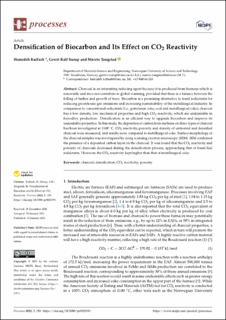| dc.contributor.author | Kaffash, Hamideh | |
| dc.contributor.author | Tangstad, Merete | |
| dc.contributor.author | Surup, Gerrit Ralf | |
| dc.date.accessioned | 2021-03-10T11:54:34Z | |
| dc.date.available | 2021-03-10T11:54:34Z | |
| dc.date.created | 2021-01-21T19:06:40Z | |
| dc.date.issued | 2021 | |
| dc.identifier.citation | Processes. 2021, 9 (2), . | en_US |
| dc.identifier.issn | 2227-9717 | |
| dc.identifier.uri | https://hdl.handle.net/11250/2732608 | |
| dc.description.abstract | Charcoal is an interesting reducing agent because it is produced from biomass which is renewable and does not contribute to global warming, provided that there is a balance between the felling of timber and growth of trees. Biocarbon is a promising alternative to fossil reductants for reducing greenhouse gas emissions and increasing sustainability of the metallurgical industry. In comparison to conventional reductants (i.e., petroleum coke, coal and metallurgical coke), charcoal has a low density, low mechanical properties and high CO2 reactivity, which are undesirable in ferroalloy production. Densification is an efficient way to upgrade biocarbon and improve its undesirable properties. In this study, the deposition of carbon from methane on three types of charcoal has been investigated at 1100 °C. CO2 reactivity, porosity and density of untreated and densified charcoal were measured, and results were compared to metallurgical coke. Surface morphology of the charcoal samples was investigated by using scanning electron microscopy (SEM). SEM confirmed the presence of a deposited carbon layer on the charcoal. It was found that the CO2 reactivity and porosity of charcoals decreased during the densification process, approaching that of fossil fuel reductants. However, the CO2 reactivity kept higher than that of metallurgical coke. | en_US |
| dc.language.iso | eng | en_US |
| dc.publisher | MDPI | en_US |
| dc.rights | Navngivelse 4.0 Internasjonal | * |
| dc.rights.uri | http://creativecommons.org/licenses/by/4.0/deed.no | * |
| dc.title | Densification of Biocarbon and Its Effect on CO2 Reactivity | en_US |
| dc.type | Peer reviewed | en_US |
| dc.type | Journal article | en_US |
| dc.description.version | publishedVersion | en_US |
| dc.source.volume | 9 | en_US |
| dc.source.journal | Processes | en_US |
| dc.source.issue | 2 | en_US |
| dc.identifier.doi | https://doi.org/10.3390/pr9020193 | |
| dc.identifier.cristin | 1876831 | |
| dc.relation.project | Norges forskningsråd: 294679 | en_US |
| dc.description.localcode | © 2021 by the authors. Licensee MDPI, Basel, Switzerland. This article is an open access article distributed under the terms and conditions of the Creative Commons Attribution (CC BY) license (http://creativecommons.org/licenses/by/4.0/). | en_US |
| cristin.ispublished | true | |
| cristin.fulltext | original | |
| cristin.qualitycode | 1 | |

